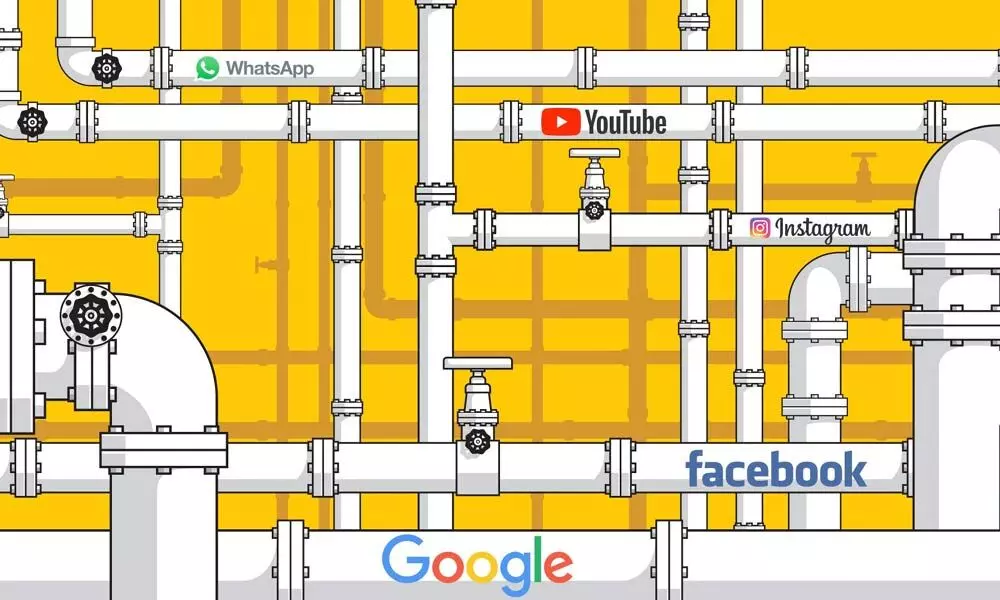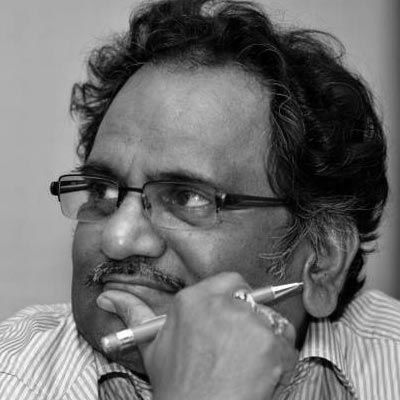Live
- Officials inspect arrangements for CM’s visit
- Iran: 1 killed, 21 injured after bus overturns
- Welfare hostels shut as bills pile up
- CM Revanth Reddy Slams BJP Leaders Over Inaction
- Minister Ponguleti visits Basara temple
- Ashutosh Gowariker to lead International Jury at IFFI 2024
- The global challenges of greener aviation
- Shreyas Media secures exclusive advertising rights for ‘MahaKumbh Mela 2025’
- Experience the journey of art
- Seven iconic ghats undergo makeover for Mahakumbh
Just In

Targeting freedom of expression?
Whether Government of India is extending its censorship power to news and current affairs’? The notification by President Ramnath Kovind extends the power to pre-censor cinema content on the Internet platform
Whether Government of India is extending its censorship power to news and current affairs'? The notification by President Ramnath Kovind extends the power to pre-censor cinema content on the Internet platform. At the same time, does it surreptitiously attempt to censor news and current affairs also?
News is categorised as film
It was a very clever drafting of notification for the Government of India. The 'news and current affairs' content on the online platforms should not have been added under the sub-category of 'Press" but it has been placed under head 'Films". Is it a mischievous or mistaken inclusion?
The Constitution of India authorised pre-censorship of 'films'. The 'pre-censorship' of news content amounts to suppression of freedom of speech and expression and makes 'press' or 'media' totally dependent upon the executive government, that happened during the infamous years of Emergency.
The Government simply used the Second Schedule of Government of India (Allocation of Business) Rules, 1961 under the heading "Ministry of Information and Broadcasting" to issue notification on November 10, published on Gazette, that says that 'films and audio visual programmes made available by online content providers' and 'news and current affairs content on online platforms" would be brought under the Ministry. Under these Rules 1961, the Ministry has nine major categories dealing with broadcasting policy administration, cable TV policy, radio, Doordarshan, films, advertising and visual publicity, press, publications, and research and reference.
The officers are trying to convince the press that it was only shift of control from Ministry of IT to Ministry of I&B, as the digital platform of OTT etc are earlier under Ministry of IT but now such content will be regulated by I&B. Their main appears to be to bring OTT platform under the regulation on par with Print, Radio, TV and Films. The online space is governed by the Information Technology Act, 2000. The Government draws super-powers from this enactment to block, filter and take down the content online. The Executive can issue orders turning off the internet services completely. Blocking the internet services is the highest form of limitation on the media and communication.
Regulations on media
It is basically not correct to say that various kinds of media were not regulated. Most powerful law that is in the hands of the government is the Information Technology Act, 2000. This Act imposed criminal liability of "intermediaries" for the content that they upload or circulate.
Under Section 69A of the IT Act, online content can also be and is taken down entirely. This section was upheld by the Supreme Court as constitutional. The process of issuing blocking orders is criticised to be "opaque and the reasoning offered in orders is not subject to public scrutiny".
There are several instances of the government using these powers to direct the service providers and social media platforms from taking down posts or pages or block certain websites. For this they have mostly used the ground of copyright violation/content piracy. Other ground is that the hosting of content that was deemed offensive. With this executive power, the Government has made the foreign digital platforms like Facebook, Twitter and YouTube to comply with these demands.
Besides this strong hand of regulatory framework of the IT Act, the digital media outlets are generally subjected to the same criminal laws, and rules governing the publication or dissemination of other forms of content, such as the laws of civil and criminal defamation, and other relevant provisions of the Indian Penal Code.
Necessary and expedient
Section 20 of Cable TV Regulation Network Act empowered the Government to prohibit transmission of content on an ambiguous ground like whenever it is "necessary or expedient" in the interest of "public order, decency or morality," or when there is a threat to the sovereignty, integrity or friendly relations of India with other states. Section 6 as well as the Programme Code is concerned with content that shows contempt for India's various communities or can incite violence. Government can issue advisories, warnings and orders, based on the Programme Code.
There are cases where the transmission was fully prohibited. For example, Aaj Tak was given an advisory for organising and broadcasting a sting operation around Muzaffarnagar riots. Janmat TV-Live India had broadcast a sting operation on prostitutes, while Aaj Tak and ABP which has telecast a conversation allegedly between terrorists. In most of these case advisories were issued.
Press Council
For print media, Press Council of India was established in 1966, which has limited powers to censure newspapers and editors. There are no powers to PCI to impose any punitive sanctions. The PCI can at the most warn, admonish or censure or disapprove or ask the newspapers to publish clarifications.
Cinema content
For cinema the Government of India has the Cinematography Act that gave power to examine the content of the cinema and permit various kinds of exhibitions including the cutting of certain scenes. Earlier the Government was aiming at regulating the digital broadcasting, which means to formulate a policy that would regulate news and current affairs content telecast through YouTube, Facebook and WhatsApp with the same vigour of control over conventional broadcasting. At present the government does not allow private FM stations to broadcast news and current affairs. But this kind of prohibition is not possible to web radios.
Another huge space for the people is to upload any video content through YouTube or WhatsApp which can be easily accessed to by all other people in India or abroad. Unlimited number of video channels emerged on varied subjects including news and current affairs. There is no condition imposed to secure licence from I and B Ministry.
Recently the Centre assured the Supreme Court while hearing the writ petition on controversy over the content vilifying the Muslim community telecast by Sudarshan News, to bring in regulation for digital media. At the same time the affidavit filed by the officer of the Ministry of Information and Broadcasting stated that sufficient framework and judicial pronouncements were already available to regulate the electronic and print media. But there were no controls over digital media, the Ministry stated.
One year ago in 2019, it was reported that Government was contemplating a censor law to control the streaming of cinema content through Netflix, Hotstar or Amazon Prime etc on the complaints alleging that content was obscene or insulting to religious sentiment.
Code of self-regulation
The Internet and Mobile Association of India (IAMAI) launched the 'Code for Self-Regulation of Online Curated Content Providers' on February 5, 2020. Earlier a 'Code of Best Practices for Online Curated Content Providers' was developed in January 2019.
While the 2019 code had nine signatories excluding Netflix, Zee5, AltBalaji, Arre and ErosNow. 2020 code has four signatories: Hotstar, Voot, Jio and SonyLiv. Major platforms like Amazon (Prime) and Google (YouTube Premium) did not join this code.
This Code 2020 seeks to establish an independent enforcement authority called the Digital Content Complaint Council (DCCC) to oversee a signatory's content related practices. This DCCC mechanism is eerily similar and largely derivative of the Broadcast Content Complaints Council (BCCC) (under the Indian Broadcasting Foundation) which essentially governs content on non-news and television channels in India.
The proposed DCCC is meant to be chaired by a retired High Court or Supreme Court judge. Also, the DCCC is designed to include three members from national level statutory commissions like the National Commission for Women (NCW), the National Commission for Protection of Child Rights (NCPCR) or the National Human Rights Commission (NHRC).
It is not known how this code has been developed, who the stakeholders consulted and how effective it could be. The code gives power to remove the content i.e., to censor the digital content of cinema, news and current affairs, on very ambiguous grounds. Hence it is not possible to give legal status to this code also.
A renewed attempt to control
The present attempt of the Union Government to control the content of the cinema on digital platform and also news and current affairs has every potential issue of imposing pre-censorship kind of restrictions on the freedom of speech and expression which is not envisaged under Article 19(1)(a) and (2). If the notification signed by the President on November 10 means another attempt to curb the criticism. Censoring cinema content could not be a major issue, as that was already permitted, but extend similar restrictions to news content will suppress the voices, opposition, dissent, and criticism, which is totally against the democracy.
(The writer is Dean, School of Law, Bennett University, and former Central Information Commissioner)

© 2024 Hyderabad Media House Limited/The Hans India. All rights reserved. Powered by hocalwire.com







